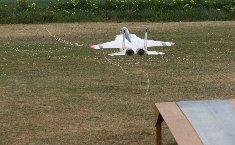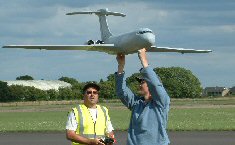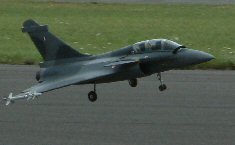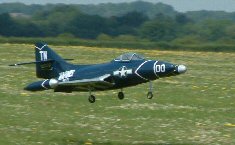|
|||
|
|
|
||
| View Shopping Cart |
| Home |
| Guides Available |
| About the Author |
| FAQs |
| Testimonials |
| Articles |
| Contact Andrew |
| Terms & Conditions |
| Mailing List |
| Links |
 |
 |
Get more great
articles like this one absolutely free with every
Gibbs Guides e-magazine. Join
the mailing list!
Electric Ducted Fan (EDF) Models
Part 3- Getting airborne
Article by Andrew Gibbs

Launching EDF models
There are two ways to get an EDF model airborne. Medium size and larger
models are usually equipped with retractable gear, so provided a suitable
take off area is available they can get airborne under their own power.
However, smaller models cannot usually accommodate the weight and volume of retractable gear, so another means has to be used to take to the sky. Many EDF models have higher wing loadings than ordinary sport models, meaning they have to fly fast to stay airborne. This means that hand launching is simply not an option for many EDF models, as it would not be humanly possible to throw the model fast enough to reach flying speed.
| EDF caption (click small images to enlarge). | EDF caption (click small images to enlarge). |
Bungee Launching
For such models a bungee or catapult launch is an excellent method to
get airborne. The solution is a bungee or catapult launch for which the
model requires only a suitably positioned hook. A typical bungee consists
of long length of elasticated bungee elastic plus an additional length
of non-elasticated cord at the model end. The model is connected to the
bungee in its stretched condition and, when the pilot is ready, it’s
released. A foot operated release mechanism is invariably used.
A refinement which is sometimes employed is the use of a ramp which increases
the model’s angle of attack and helps it gain a little height at
the beginning of the launch. Alternatively a small set of wheels may be
added to the bungee itself which serve a similar function. Catapult launching
models may sound a bit dicey if you’ve never seen it in action,
but in practice it proves to be a very reliable way of getting a model
airborne.
| An F15 getting airborne from a ramp assisted bungee launch (click small images to enlarge). | This VC10 is built entirely from foam and is incredibly light, allowing it to be hand launched. Richard Vale is the builder, seen holding the transmitter (click small images to enlarge) |
| Typical nose high attitude of a jet being landed(click small images to enlarge). | Typical nose high attitude of a jet being landed |
Flying EDF models
EDF models often fly fast, and this means they'll need more space than
a smilarly sized prop driven sport model.
The speed of EDF models need not be intimidating; you can practice with a high performance prop driven model before taking the plunge into the EDF variety.
Landing
Landing an EDF model is not very different from a prop driven model. However,
planning the approach is a little more important, since EDF models are
often slippery, and with no prop to act as a brake they may be more challenging
to slow down.
Larger models can be equipped with flaps, and these, in conjunction with a well planned approach, can allow a model to more easily be brought in to land at easily manageable speeds.
Conclusions
I hope you’ve enjoyed this foray into the world of jets. I’ve
endeavoured to do more than simply provide you a set of pretty pictures;
the spread of captions combined with the text is an effort to give you
a broad overview of the exciting world of EDF models.
Learn more about launching EDF models here





